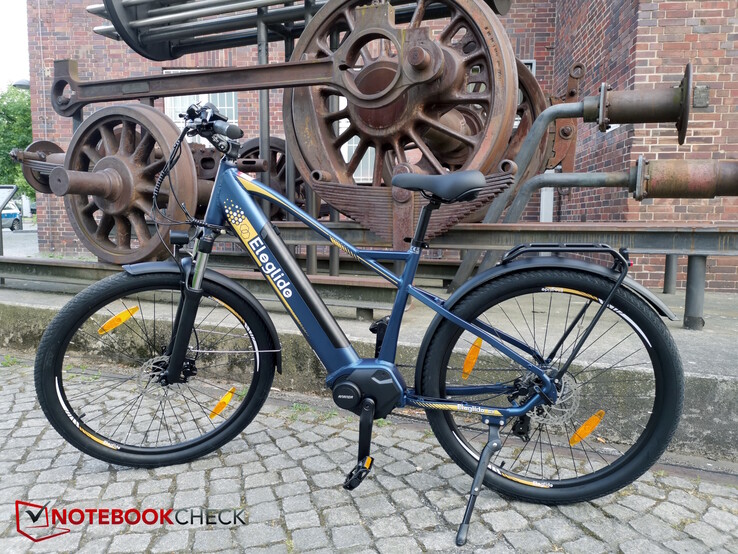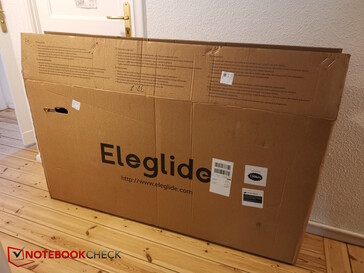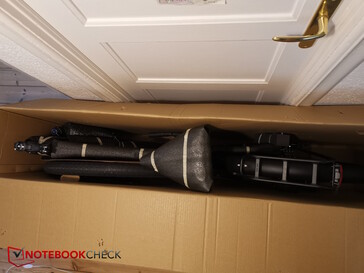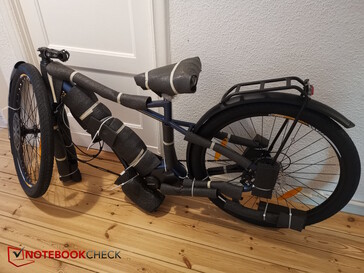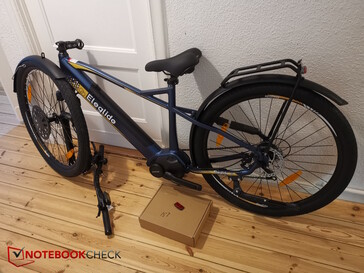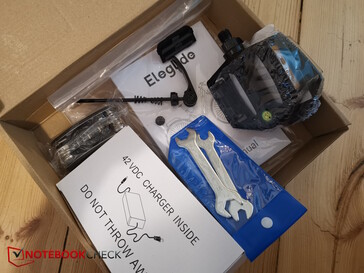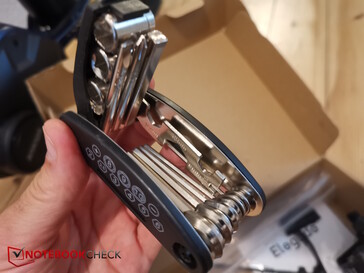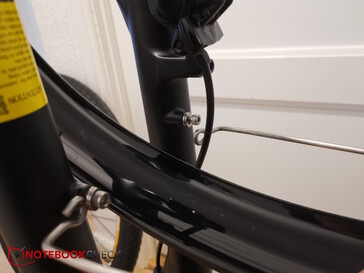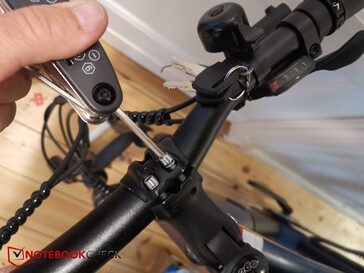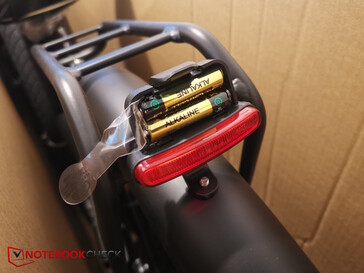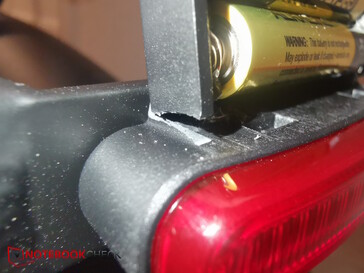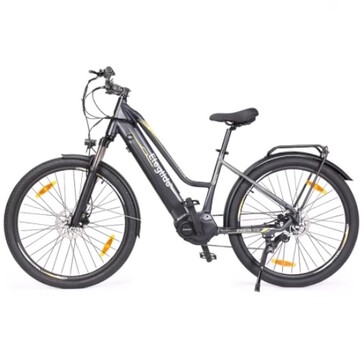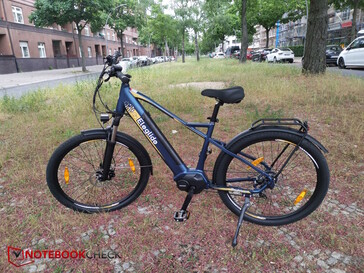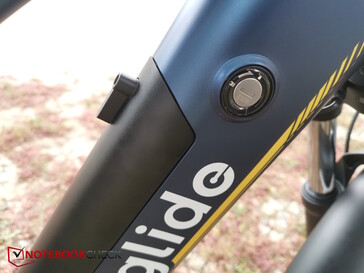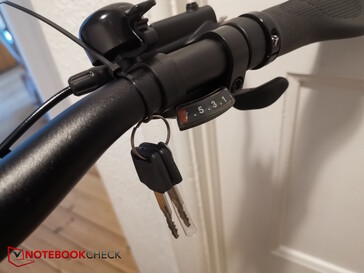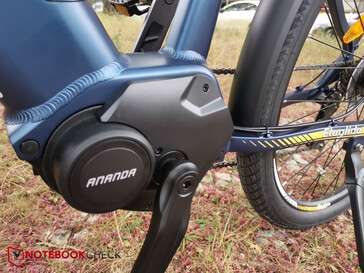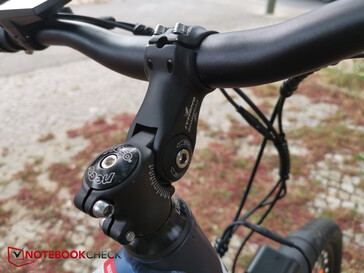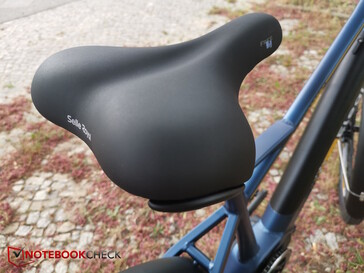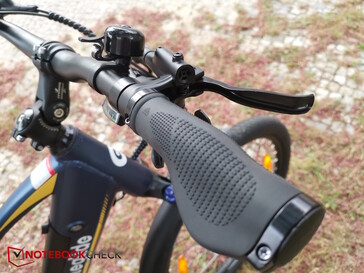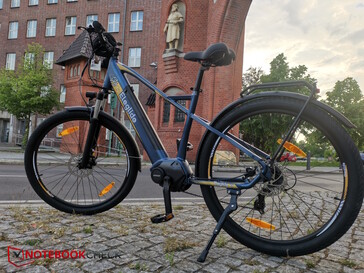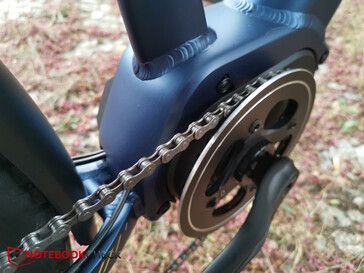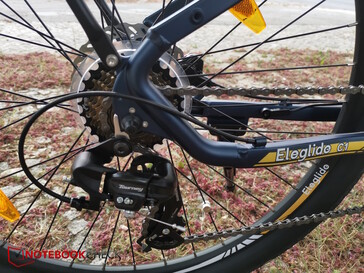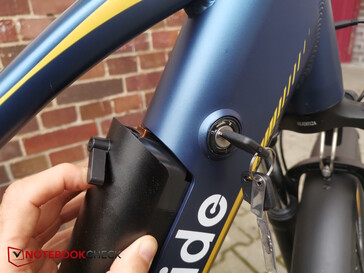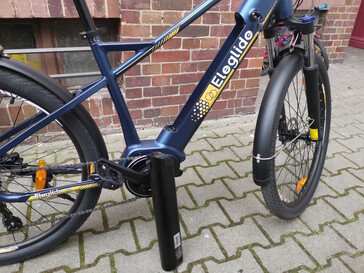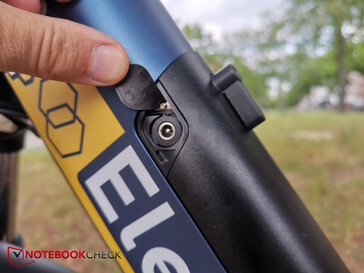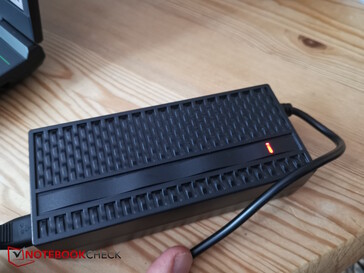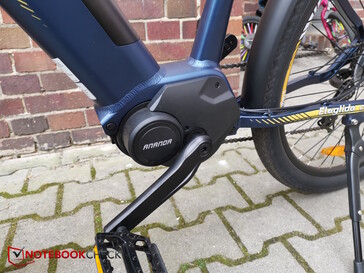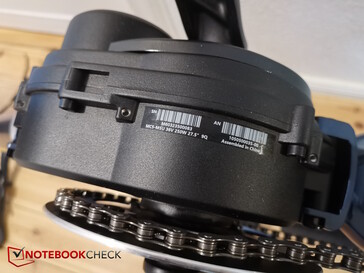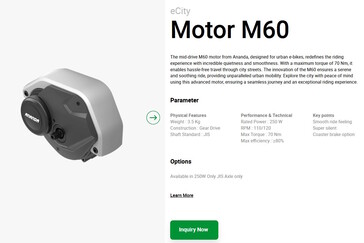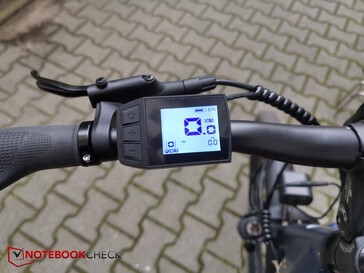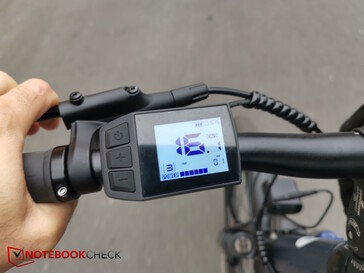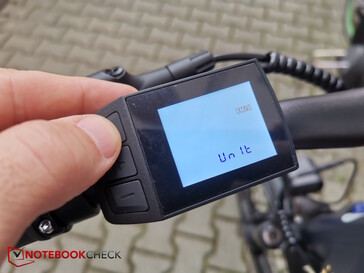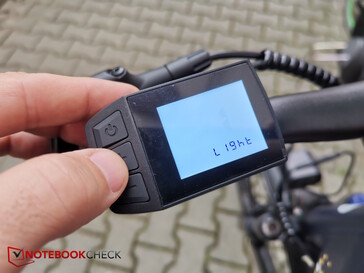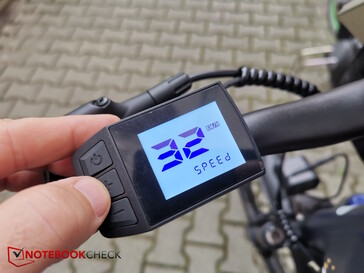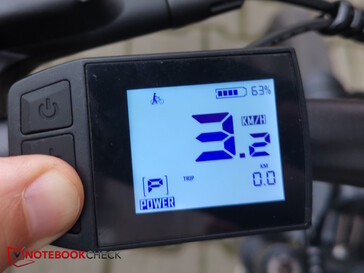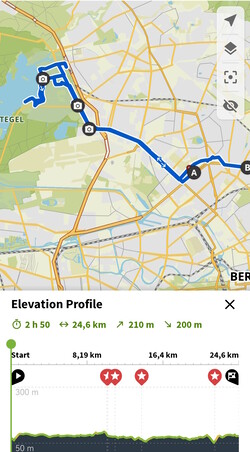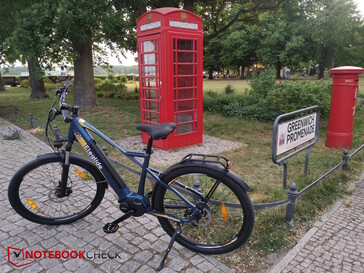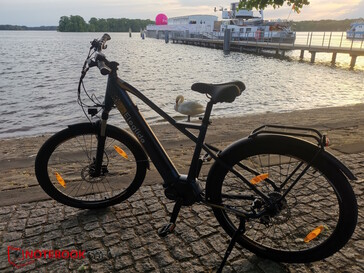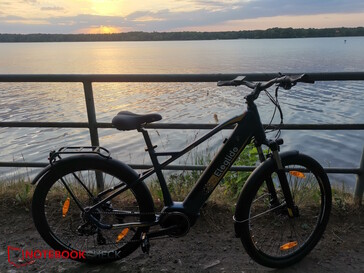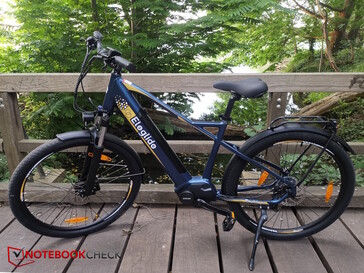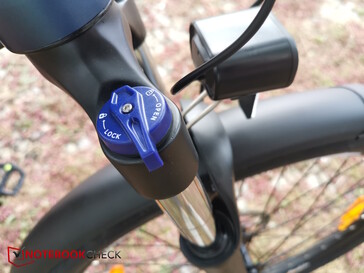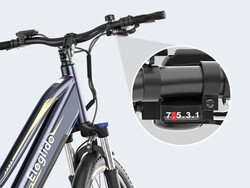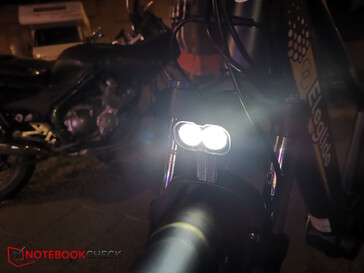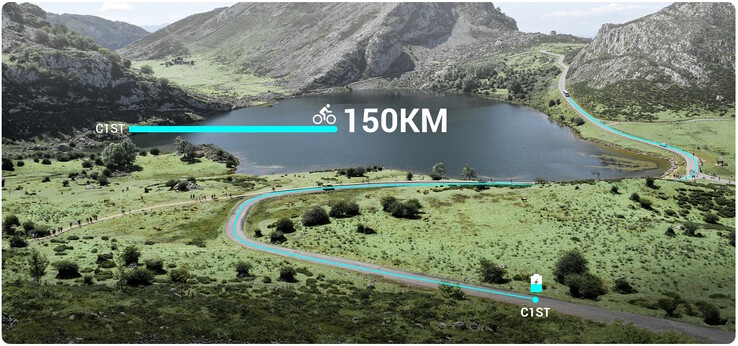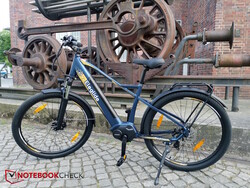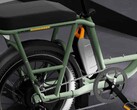Eleglide C1 trekking e-bike review: 27.5-inch wheels with mid-motor and a questionable design choice
We have already tested two e-bikes from this company: the Eleglide Citycrosser e-city bike (approx. US$1.226) and the Eleglide M2 e-mountain bike (approx. US$1.000). The new C1 is slightly more expensive at US$1.448, but still relatively affordable. This trekking bike features hydraulic disc brakes, a suspension fork, 7-speed Shimano rear derailleur, and a mid-motor, unlike the rear-wheel motors found in the previously mentioned bikes.
Assembly: Tail light did not survive the shipment
The bike is shipped in a large cardboard box with ample plastic insulation and protective material. Once the cable ties and plastic are removed, the straightforward assembly can begin.
Now, the handlebars, front light, front mudguard, front wheel, and pedals need to be fitted, meaning they need to be bolted on—after which the e-bike is ready to ride.
Incidentally, both the front and rear wheels are equipped with quick-release skewers, which can make it easier for potential thieves. You may have to worry about returning to an e-bike without a front wheel one day.
There was one issue with the setup, concerning the rear light. Firstly, as with the Citycrosser, it is inexplicably separated from the rest of the electrical circuit, requiring extra batteries (2x AAA, included) to operate. Unlike the front light, which is powered by the e-bike battery, this separation means that you could find yourself riding in the dark with a fully charged battery while the rear light suddenly goes out due to drained batteries.
However, the more pressing concern is that the apparently cheap rear light did not survive transportation. The plastic housing of the battery compartment is broken at its most vulnerable point and now leans backward. Consequently, there is no longer any contact between the battery compartment and the light; it only illuminates when the battery compartment is pushed forward. Because of the damage, the reflector cover of the battery compartment no longer stays in place and falls off immediately. A replacement rear light is therefore needed.
Equipment and optics: Two options weighing 56.22 lbs
The frame construction of our entry-level model is quite stable, particularly the down tube, which houses the battery. The battery is secured against accidental removal by a safety lever that must be pressed when taking it out, and it can also be locked; two keys are included.
However, the low crossbar may pose challenges when mounting a child seat, though we did not test this.
The handlebar stem can be slightly tilted upward, the saddle is relatively comfortable, and the grips feature a flattened palm rest. Overall, the bike weighs 56.22 lbs, which is not unusual, but it can be quite heavy when climbing stairs over time.
| Specs | Eleglide C1 |
|---|---|
| Motor | 36 V, 250 W (short-term max 432 W) |
| Sensor | Motion sensor/rotation sensor |
| Torque | 70 Nm |
| Max speed | 25 km/h |
| Battery | 522 Wh |
| Charge time | 7.5 h |
| Display | 1.8 inch |
| Drive | Chain |
| Brakes | Hydraulic disc brakes |
| Weight | 56.22 lbs |
| Tyres | 27.5 inch * 2.25 pneumatic tires |
| Miscellaneous | Steel suspension fork (3.94 inches suspension travel), kickstand, aluminum pedals |
| Security | Battery lock |
| Price | US$1.448 |
Unlike the similarly priced PVY Libon, the Eleglide C1 unfortunately does not use a torque sensor; it relies solely on a rotation sensor, which we will cover in the real-life test ride section.
The drive system uses a chain mechanism, with a Shimano Tourney gear shifter.
Brakes, suspension fork and tyres
The tyres measure 27.5 inches in diameter and are 2.25 inches wide, with an optimum air pressure of 55 to 60 PSI. The hydraulic disc brakes are well-adjusted and operate quietly, even with the front wheel fitted by the rider.
The suspension fork offers 3.94 inches of suspension travel, and it can be locked out by turning the blue wheel located on the top right-hand side of the fork.
Battery: 522 Wh, 36 V and long charging time
The battery has a capacity of 522 Wh (14.5 Ah) at a voltage of 36 V. It is housed in the down tube of the bike and can be locked in place, but it can also be easily removed for charging and taken indoors. Unfortunately, charging takes a considerable amount of time—7.5 hours—especially since better battery technology is now available. For instance, the dual 10 Ah battery in the PVY Libon charges in "just" 5 hours.
According to Eleglide, the battery should provide a range of up to 150 km. This figure was obtained with a rider weight of 165.35 lbs on a flat, straight route with minimal headwind, and at a speed of only 9.32 mph. In the real-life test ride section, we will provide our findings based on everyday use.
Motor: 70 nm torque by Ananda
The manufacturer of the 250 W mid-motor is Ananda, a Chinese company based in Shanghai. The installed M60 is Ananda's entry-level motor, providing a torque of 70 Nm. This power is generally sufficient for urban commuting and lighter tours, but if you plan to tackle steeper climbs or mountainous terrain, you may want to consider a more powerful engine.
While Ananda is not as well-known in this country as brands like Bafang, their motors are becoming increasingly popular and are reported to be quiet and reliable. However, you might encounter challenges in sourcing spare parts in the event of a breakdown.
Display and app: No app available after all
The display measures 1.8 inches and has a standard appearance. However, it does feature a USB-A port, which can be used to charge a smartphone, although this will affect battery life.
The display shows key information, including speed, support level (ranging from 1 to 5), battery level, and trip mileage. You can switch to the total mileage by briefly pressing the power button, a detail not mentioned anywhere in the manual.
The display is operated via three buttons: Plus, Minus, and Power. By pressing the Plus and Minus buttons for a few seconds, you can access the menu. In this menu, you can adjust several settings, including the display brightness and units (e.g., km vs. miles), as well as performance parameters such as the maximum speed, which can be set up to 19.88 mph.
Während bei anderen Herstellern immer prominent auf die, in den meisten Fällen mäßig nützliche, App hingewiesen wird, führt die Bedienungsanleitung von Eleglide keine Software auf und die Einstellungen im Display listen auch keine Bluetooth-Funktionalität auf. Ob das gut oder weniger gut ist, mag jeder für sich entscheiden, als Tester war es ganz schön mal keine überflüssige App austesten zu müssen.
While other manufacturers often highlight their apps, which are typically of moderate use, Eleglide's operating instructions do not mention any software, and the display settings do not indicate any Bluetooth functionality. Whether this is a positive or negative aspect is subjective, but as a tester, it was refreshing not to have to evaluate a redundant app.
Real-life test ride: It requires some adjustment time
For our test ride, we took a trip from Sees Street near the Bornholmer Street to the Tegler Lake. The route, which spanned approximately 15.5 miles, primarily consisted of cycle paths with minimal elevation changes, and the wind conditions were moderate. There were a few unpaved paths around the lake, but those were quite rare.
We then returned along a similar route, which resulted in a total distance of about 15.3 miles.
With the addition of a chain lock and other gear, the rider's weight was approximately 165.35 lbs. During the ride, we primarily used support level 3, though we occasionally switched to other levels, as detailed in the riding experience section.
Ride experience
The gears worked adequately, though they were not perfectly adjusted; occasionally, shifting to a higher gear required a little more effort. The front suspension fork provided smooth damping, and the braking performance was satisfactory. The overall ride experience can be described as multifaceted, primarily due to the pedal sensor.
Since our last experience with an e-bike equipped with a torque sensor, specifically the PVY Libon, we immediately noticed how differently the Eleglide C1 reacts with its motion sensor. With a torque sensor, the assistance is activated based on the force applied to the pedals. Pedaling harder results in increased assistance, allowing for better control over the assistance behavior.
In contrast, the pedal sensor on the Eleglide C1 is more affordable, but it results in a different riding experience. First and foremost, the assistance often feels slightly delayed, which can be frustrating when starting off on a heavier bike like the C1. Additionally, the assistance behavior is much less consistent. The motor primarily engages—though not exclusively—based on cadence. This encourages you to shift gears appropriately; if you start off in a higher gear, you'll receive significantly less assistance. However, shifting to a lower gear at the start provides much stronger assistance due to the increased cadence.
Depending on the assistance level, additional power diminishes at certain speeds. At higher velocities, the selected assistance level (ranging from 1 to 5) becomes crucial. For instance, while assistance at level 3 feels excessive at lower speeds, it nearly disappears once you exceed approximately 11.2 mph. Therefore, if you prefer to cruise leisurely at around 9.3 mph, you should choose level 1 or 2; otherwise, you'll find yourself accelerating too quickly. To maintain assistance at speeds above 12.4 mph, level 5 is required.
Gear changes must be made more quickly depending on the driving conditions; this requirement is less pressing when a torque sensor is used. After all, the drop in assistance doesn’t occur abruptly; we felt that each gear at least prevents you from having to work against the motor, even when exceeding its maximum speed.
On the way back, we rode into the darkness, providing an opportunity to test the lights—the front light, since the rear light was defective. The front light performed flawlessly.
When the motor is switched off, the C1 becomes somewhat cumbersome to ride, highlighting its substantial size and weight. Therefore, longer trekking tours require careful planning, ensuring that charging stations are conveniently located along the route. As such, we view the Eleglide more as a city bike rather than a suitable option for extensive trekking adventures. Additionally, if you need to carry the e-bike up and down stairs or over other obstacles, you will need considerable strength.
Range
Eleglide claims a range of 93 miles. This was tested with a weight of 165 lbs, on an almost flat route (yeah), with little wind (uhh, we did encounter some wind, but not much), and at a constant speed of 9.3 mph. Of course, our experience was different; we rode normally in city traffic, stopping at traffic lights, starting again, and tended to ride at around 15.5 mph when conditions allowed. Our average speed was 11.3 mph.
We started with a battery level of 93 percent, and after covering 15.3 miles, this dropped to 48 percent. The battery level indicator is noteworthy in itself. When we used the bike again a few days later, the battery level had risen to 64 percent. Based on both readings, a full battery charge should provide a range of approximately 35 to 52 miles with our riding style. If you shift gears more dynamically and adapt the support modes more quickly to the riding conditions, you might even exceed the 62-mile mark. However, certainly not in mountainous terrain as depicted in Eleglide's marketing imagery.
Pros
Cons
Verdict: Value for the money, compromises, and rear light issues
The Eleglide C1 is a stable and fairly large e-bike, featuring good suspension travel and thicker tires. Depending on your riding style, the battery lasts approximately 43.5 to 62 miles. Once you master the optimal interplay of gears and support modes, riding becomes enjoyable.
However, we would have preferred a torque sensor instead of the standard pedal sensor, though this would likely increase costs. Additionally, we find it puzzling that Eleglide continues to separate the rear light from the main electrical circuit, requiring separate batteries—especially considering the quality is somewhat subpar, as evidenced by our battery compartment breaking during shipping.
The Eleglide C1 requires some adjustment to learn the perfect balance between shifting and support levels. Once you've figured it out, you can truly enjoy the ride. Moving forward, we hope that future models will integrate the rear light into the battery circuit.
Price and availability
Geekmaxi is usually selling the bike for US$1.448.
Transparency
The selection of devices to be reviewed is made by our editorial team. The test sample was provided to the author as a loan by the manufacturer or retailer for the purpose of this review. The lender had no influence on this review, nor did the manufacturer receive a copy of this review before publication. There was no obligation to publish this review. As an independent media company, Notebookcheck is not subjected to the authority of manufacturers, retailers or publishers.
This is how Notebookcheck is testing
Every year, Notebookcheck independently reviews hundreds of laptops and smartphones using standardized procedures to ensure that all results are comparable. We have continuously developed our test methods for around 20 years and set industry standards in the process. In our test labs, high-quality measuring equipment is utilized by experienced technicians and editors. These tests involve a multi-stage validation process. Our complex rating system is based on hundreds of well-founded measurements and benchmarks, which maintains objectivity. Further information on our test methods can be found here.




